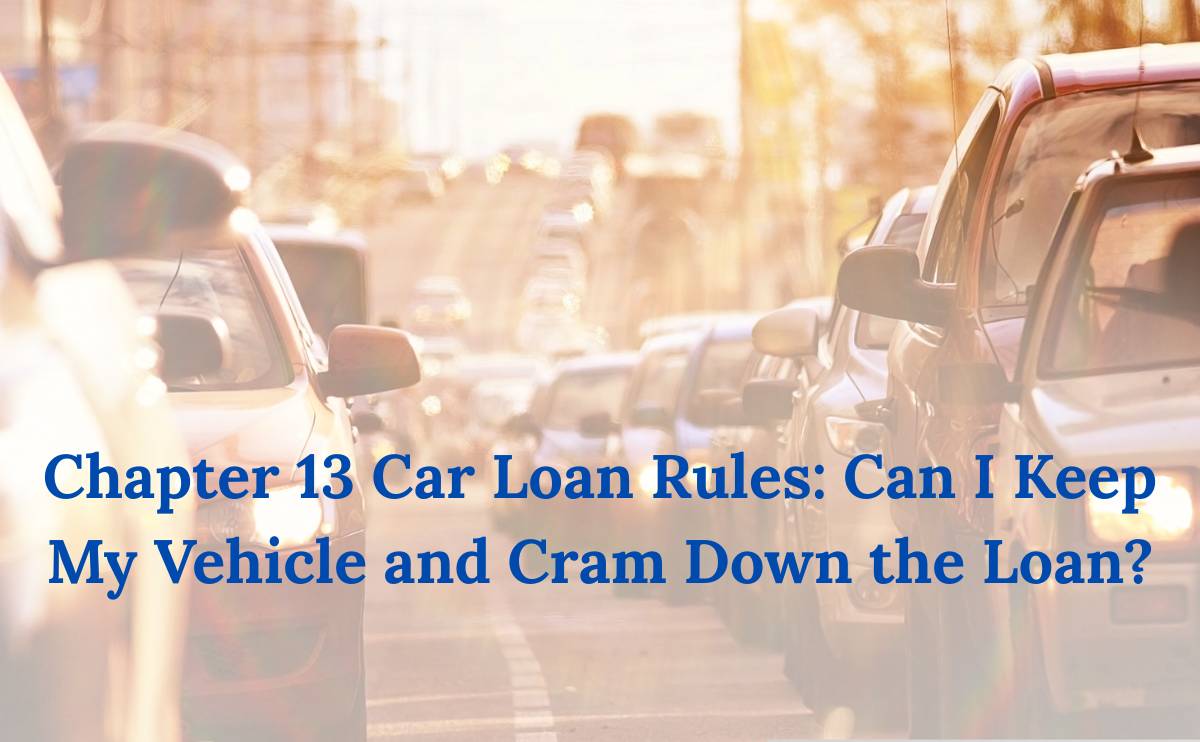Free Consultation
To discuss your financial situation and learn more about your debt relief options, give us a call at (520) 745-4429 or (480) 788-0098.
 Tucson(520) 745-4429
Tucson(520) 745-4429
 Mesa/Phoenix (480) 788-0098
Mesa/Phoenix (480) 788-0098

Missing a car payment can snowball fast, especially when every day starts with a drive to work or school. Reliable transportation is more than a luxury; it is a lifeline, and losing that lifeline can threaten the rest of your finances.
At Yusufov Law Firm PLLC, we help people across Mesa, Phoenix, and Tucson tackle money problems through bankruptcy, debt defense, and debt settlement. This article breaks down how Chapter 13 bankruptcy treats car loans, why the “cram down” tool can slash what you owe, and what rules decide whether you can keep your car.
Chapter 13 gives you the chance to keep assets while paying creditors through a three- to five-year plan approved by the court. Because the repayment plan stretches out debt, you can catch up on past-due car payments, reduce the interest rate, and sometimes cut the loan balance itself. In Arizona, the combination of state exemption laws and the federal Bankruptcy Code often makes Chapter 13 the most car-friendly option for residents who are behind yet still need their vehicle.
Bankruptcy exemptions decide how much property you can protect. Arizona offers a motor-vehicle exemption (currently $16,000 for most filers and $26,700 for those with certain disabilities, adjusted annually) that shields that amount of equity from creditors.
In Chapter 7, a trustee would sell non-exempt property, give you the exempt cash, and forward any remaining funds to creditors. Chapter 13 works differently. You keep everything, even non-exempt assets, but you must pay unsecured creditors an amount at least equal to the non-exempt equity.
Consider these examples to see the difference:
If you are upside down on the loan and do not want the vehicle, you can surrender it. The lender sells the car, and any remaining balance becomes unsecured debt, paid off at a fraction of its value through the plan. For those who wish to keep the car, payments must continue; otherwise, the lender may request permission from the court to repossess the vehicle.
Whether payments go directly to the lender or through the Chapter 13 trustee depends on local practice. In the District of Arizona, car payments must usually be made through the trustee, regardless of whether you are behind on payments when the bankruptcy is filed. Always confirm local rules with counsel because they vary by locality.
A cram down allows you to split the lien into two pieces: secured up to the car’s fair market value and unsecured for the remaining amount. You pay the secured portion in full through the plan, usually at a lower interest rate, and the unsecured part is discharged with other unsecured debts once you finish the case.
Suppose you owe $18,000 on a sedan worth $11,000. With a successful cram down, you pay $11,000 plus interest, not $18,000. The $7,000 difference moves to the unsecured column and is likely wiped out when the plan ends.
Not every loan qualifies. Congress built guardrails into the Bankruptcy Code to stop last-minute shopping sprees. The main rule is the “910-day test.”
The table below highlights other key differences that matter when deciding between Chapter 7 and Chapter 13 for car protection.
| Issue | Chapter 7 | Chapter 13 |
| Keep Payments Current? | Must remain current if want to keep, otherwise can be repossessed | Can cure arrears over up to 60 months |
| Cut Interest Rate | Not available | Yes, usually the prime rate plus the risk factor |
| Reduce Principal (Cram down) | No | Yes, if the 910-day rule is satisfied |
| Effect of Non-Exempt Equity | The trustee may sell | Keep, but pay value to unsecured creditors |
| Trustee Fee on Car Payments | N/A | Up to 10 % on plan disbursements |
Leases play by slightly different rules. The automatic stay stops repossession right after filing. You can then decide to either assume or reject the lease as part of the Chapter 13 plan. If the lease is assumed, you can keep the car and must continue making payments. If the lease is rejected, the stay ends, and you will surrender the vehicle.
Surrendering triggers the lessor’s right to sell the car and file an unsecured claim for any shortage. Assuming the lease means you remain bound by mileage limits and end-of-term fees, so check whether the payment fits your budget before moving forward.
Beyond chopping principal, a cram down can reduce the interest rate. Courts follow the Supreme Court’s Till formula: prime rate plus a small risk premium of 1 to 2%. Lower interest paired with reduced principal can push the monthly payment well below the original contract amount.
Three perks flow from this structure:
Yes. While this may differ from jurisdiction to jurisdiction, in Arizona, you will normally pay off your car through the bankruptcy plan. Once your plan is completed, the lender releases its lien, and you drive away debt-free. Most Arizona filers finish Chapter 13 owing nothing on their vehicle.
Keeping a car while paying off the loan balance can significantly alter the overall picture of your finances. Yusufov Law Firm PLLC guides clients through the cramdown process and every other part of Chapter 13. Call us in Tucson at (520) 745-4429 or in Mesa/Phoenix at (480) 788-0098 or reach out through our Contact Us page. Let us review your loan details, check the 910-day rule, and craft a plan that puts you back in the driver’s seat. We look forward to helping you move forward with confidence.
To discuss your financial situation and learn more about your debt relief options, give us a call at (520) 745-4429 or (480) 788-0098.
© 2010-2025 Yusufov Law Firm PLLC. All Rights Reserved | Disclaimer | Sitemap |